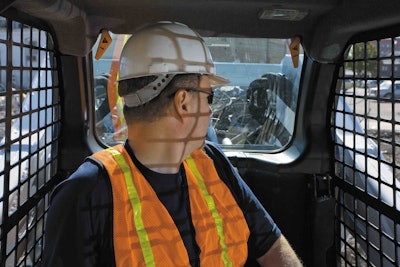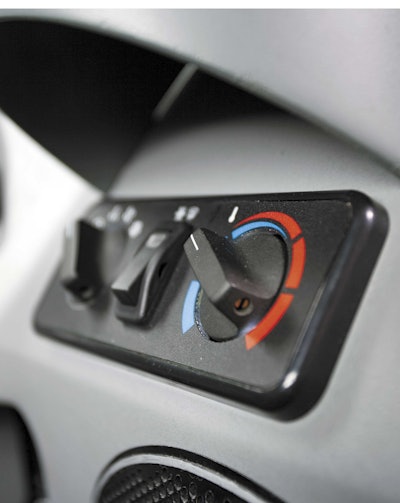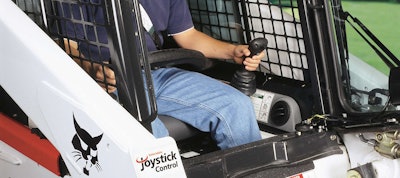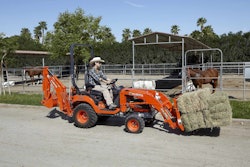
You arrive early on the jobsite, ready to go to work. You open the door on the enclosed cab of your new compact loader and climb in through the roomy opening. You put your coffee in the cup holder. Someone with shorter legs than yours was running the loader yesterday afternoon, so you quickly adjust the seat to fit your larger frame.
You close the door, muting the sound of the diesel pickup truck that has just pulled in next to you. You fasten your seatbelt, lower the safety bar, enter your password in the keypad and start the engine. You plug in your MP3 player to the loader’s stereo and select the new music you downloaded last night at home. Your mobile phone needs charging, so you plug the charger into the 12-volt power accessory.
It’s been cool for this time of year, so you turn on the cab’s heater and adjust the airflow. Later in the day, you may switch on the air conditioning as things warm up. The sun is still below the horizon, so you turn on the halogen work lights. You look behind you to see who else has arrived on the jobsite and then grasp the joystick controls and head off to where a truck has just dumped a large pile of
topsoil.
Ah yes, just another day at the office. But for manufacturers of compact loaders, operator comfort and ergonomics have taken center stage in new product design as contractors battle to keep operators happy, productive — and on staff.
“It’s hard to get good operators and harder to keep them,” says Mike Fitzgerald, loader product specialist at Bobcat Company, West Fargo, N.D. “Operator expectations have changed. They want to be comfortable, and they want to walk away from the machine at the end of the day and not feel tired.”
“What was acceptable 20 or 30 years ago is no longer acceptable,” Fitzgerald says. “Today it’s critical that we offer air conditioning, radios and other items that we didn’t even sell in the past.”
Listening to the customer

Listening to customers plays a large role in the cab design process, Maus says. Manufacturers call this “voice of the customer,” or VOC for short.
“VOC plays a big role in cab design and development,” Maus says. “Manufacturers need to understand early on what customers want before they can implement new items into the design. This does not just involve the cab. VOC for the entire machine must be understood before designing the product.”
Gathering VOC data is a continual process for manufacturers, Fitzgerald says.
“Product specialists like myself, district field managers and district service managers all visit customers to see how machines are used in the field,” he says. “Dealer sales and service representatives also feed information back to us as manufacturers. In addition, engineering personnel may visit jobsites to look at specific machine features or specific size machines. So there’s a lot of ways that we can gather VOC information.”
Improved control access is a major VOC item. For example, this was taken into account for all of the controls and throttle layouts within the cabs of new Bobcat M-Series loaders, Maus says.
Cup holders and storage locations are also major requests from operators, he said. By designing these into the cab early on, engineers are able to maintain good spatial relationships between these items and the rest of the functions within the cab.
A cleaner, quieter and cooler cab were all major requirements revealed by VOC. Knowing this, Maus says, engineers made a conscious effort to dedicate space and design time to cab seals, the heating and cooling system and air filtration of the cab.
Industry standards play a part
Industry standards also play a part in cab design, Maus says. He notes that standards set out by ISO (International Organization for Standardization) and SAE (Society of Automotive Engineers) are followed when it comes to items like drive control locations, overall visibility, seat locations, seat belt requirements and display requirements. An example is ISO 5006, which relates to the operator’s field of view for earthmoving machinery.
Fitzgerald notes that while ISO and SAE create standards, they do not have regulatory authority. In addition, manufacturers often add features to equipment, like backup alarms, that are not in the standards for skid steer loaders but may be required on certain jobsites by government regulators like OSHA.
“Often, manufacturers do this because it’s a benefit to both owners and operators to have that feature,” he says.
Designing cabs that meet the needs of international markets is another challenge. One solution is to have a design that will accommodate all regions worldwide.
“There are always different requirements from various regions that must be met and taken into account,” he says. “Typically, we offer a kit or an option designed to meet regional needs. For example, in parts of Europe, they may need a road light kit, turn signals, a beacon or strobe light.”
Fitzgerald notes, “We design the cab to accommodate those variations in specific locations.”
Hand in hand with designing for international markets is the need to accommodate operators of various heights and sizes. Most manufacturers now use computer-based 3D modeling software to analyze the space requirements needed to meet a broad spectrum of operators.
“Typically what we do is enter the parameters of the ISO 5006 visibility standards into the 3D software program and evaluate the machine that way,” Maus says. “Then, when we feel we have a design that will work well, we build a prototype and evaluate it in a test lab.
“We can use the 3D software to check for compatibility with what we would consider a 95th percentile individual,” he says. “In other words, we check for someone who is 95 percent bigger than the smallest person and 5 percent smaller than the biggest person.” This kind of testing affects the location of controls and comfort features such as the seat.

“During the past 10 years or so, the market focus seems to have shifted toward operator comfort,” Maus says. “Things such as cab pressurization, control access and operator space have become more prevalent in customer feedback than they were before.”
One reason why may be more hours per day and more days per year spent in the machine, both by operators who work for a contractor and contractors who operate their own machines.
“It’s fair to say that in today’s world, contractors are under the gun,” says Jason Magnuson, product function leader for cabs and interiors at Bobcat Company. “They need to meet tight deadlines, so they’re trying to get as much productivity out of their machines as they can. They’re taking fewer days off and working on more bad weather days.”
The result is that contractors and operators are spending more time in the cabs of their machines than ever before, making the cab environment far more important.
“The control layout, overall visibility and comfort features such as cup holders can have a big impact on the operator’s ability to accomplish work comfortably and quickly,” Maus says.
The cup holder may seem trivial in the overall scope of the machine design, Fitzgerald notes, but he said literally hundreds of customers have asked him for just that feature over the years.
“The fact that we have one in there is the result of customer requests,” he says.
Here are things that the operator and/or owner should look for in the cab design of a compact loader:
- Does the cab offer all of the features I am looking for? For example, a radio is something that the operator may want, but it may not be standard on many machines in the industry.
- Overall room is important, especially for larger individuals who may feel cramped and uncomfortable if the cab isn’t big enough for them. The seat bar, seat belt, controls and cab threshold will all be factors in the operator’s overall comfort level while sitting in the machine as well as when entering and exiting.
- Some smaller operators may be uncomfortable in the machine if the cab does not offer enough adjustability to accommodate them.
- There are many different control options available in the industry. The owner will want to be sure that the machine has a style of controls that is familiar to his operators.
– Information provided by Bobcat









